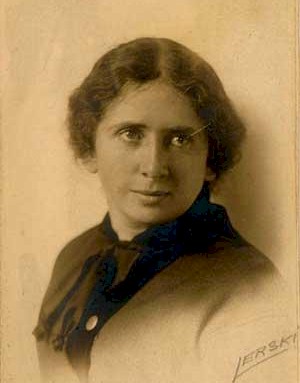- Rose Schneiderman
Infobox Person
name = Rose Schneiderman

image_size = 180px
caption =
birth_date = birth date|1882|4|6|mf=y
birth_place =Poland
death_date = death date|1972|8|11|mf=y
death_place =
occupation = U.S. labor union leader
spouse =
parents =
children =Rose Schneiderman (April 6, 1882 – August 11, 1972) was a prominent United States labor union leader and socialist of the first part of the twentieth century.
Early years
Born in either Saven or
Chełm ,Poland under Russian rule, she and her family emigrated to the United States in 1890. Her father died two years later, forcing her mother to place her in an orphanage for more than a year.Schneiderman went to work in 1895, starting as a cashier in a department store and then in 1898 as a lining stitcher in a cap factory in New York City's
Lower East Side . In 1902 she and the rest of her family moved briefly toMontreal , where she developed an interest in both radical politics and trade unionism.She returned to New York in 1903 and, with a partner worker, started organizing the women in her factory. When they applied for a charter to the United Cloth Hat and Cap Makers Union, the union told them to come back after they had succeeded in organizing twenty five women. They did that within days and the union then chartered its first women's local.
Schneiderman obtained wider recognition during a citywide capmakers' strike in 1905. Elected secretary of her local and a delegate to the New York City Central Labor Union, she came into contact with the New York
Women's Trade Union League , an organization that lent moral and financial support to the organizing efforts of women workers. She quickly became one of the most prominent members, elected the New York branch's vice president in 1908. She left the factory to work for the league, attending school with a stipend provided by one of the League's wealthy supporters. She was an active participant in the Uprising of the 20,000, the massive strike of shirtwaist workers in New York City led by theInternational Ladies' Garment Workers' Union in 1909.Triangle Shirtwaist Factory fire
The Triangle Shirtwaist Factory fire in 1911, in which more than 100 garment workers were burned alive or died jumping from the ninth floor of a factory building, dramatized the conditions that Schneiderman, the WTUL and the union movement were fighting. The WTUL had documented similar unsafe conditions — factories without fire escapes or that had locked the exit doors to keep workers from stealing materials — at dozens of sweatshops in New York City and surrounding communities; twenty-five workers had died in a similar sweatshop fire in Newark, New Jersey shortly before the Triangle disaster. Schneiderman expressed her anger at the memorial meeting held in the Metropolitan Opera House on April 2, 1911 to an audience largely made up of the well-heeled members of the WTUL:
Despite her harsh words, Schneiderman continued working in the WTUL as an organizer, returning to it after a frustrating year on the staff of the male-dominated ILGWU. She subsequently became president of its New York branch, then its national president for more than twenty years until it disbanded in 1950.
She also served on the
National Recovery Administration 's Labor Advisory Board in the 1930s, was a member ofFranklin Delano Roosevelt 's "brain trust" during that decade, and worked as secretary of the New York State Department of Labor from 1937 to 1944. She was a founding member of theAmerican Civil Liberties Union , active in theAmerican Labor Party in the 1930s and a close associate ofEleanor Roosevelt , who joined the WTUL in 1922.Women's suffrage
Schneiderman was an active feminist, campaigning for women's suffrage as a member of the National American Women Suffrage Association and running for the
United States Senate as the candidate of theFarmer Labor Party in 1920, receiving just 15,086 votes and finishing behind ProhibitionistElla A. Boole (159,623 votes) and Socialist Jacob Panken, (151,246). [cite book
last = Johnson
first = Willis Fletcher
authorlink = Willis Fletcher Johnson
coauthors = Roscoe C. E. (Roscoe Conkling Ensign) Brown, Walter Whipple Spooner, Willis Holly
title = History of the State of New York, Political and Governmental
publisher = The Syracuse Press
date = 1922
location =
pages = 347 - 348, 350
url = http://books.google.com/books?as_brr=1&id=NTKXoJKv1uUC&vid=OCLC03658830&dq=%22Farmer+Labor+Party%22&pg=PA350&lpg=PA350&q=Schneiderman+%28Farmer-Labor%29+15%2C086]Schneiderman saw suffrage as part and parcel of her fight for economic rights. When a state legislator warned in 1912 that "Get women into the arena of politics with its alliances and distressing contests--the delicacy is gone, the charm is gone, and you emasculize women", Schneiderman replied:
She helped pass the New York state referendum in 1917 that gave women the right to vote. On the other hand, Schneiderman opposed passage of the
Equal Rights Amendment to theUnited States Constitution proposed by theNational Woman's Party on the ground that it would deprive working women of the special statutory protections for which the WTUL had fought so hard.Legacy
Schneiderman is also credited with coining one of the most memorable phrases of the women's movement and the labor movement of her era:
Her phrase "
Bread and Roses ", became associated with a 1912 textile strike of largely immigrant, largely women workers inLawrence, Massachusetts .Schneiderman was a close personal and working associate of Maud O'Farrell Swartz, another working class woman active in the WTUL, until Swartz' death in 1937. As Schneiderman noted in a letter to a fellow WTUL member,
Schneiderman published her memoirs, "All for One", in 1967.
External links
* [http://dlib.nyu.edu:8083/tamwagead/servlet/SaxonServlet?source=schneiderman.xml&style=saxon01t2002.xsl Biography]
* [http://www.digitalhistory.uh.edu/social_history/12capmaker.cfm A capmaker's story]References
Further reading
* Endelman, Gary E., "Solidarity Forever: Rose Schneiderman & the Women's Trade Union League",Beaufort Books 1981
* Orleck, Annalise "Common Sense and a Little Fire: Women and Working-Class Politics in the United States, 1900-1965", Chapel Hill: University of North Carolina Press 1995
* Schneiderman, Rose, "All for one", New York, P. S. Eriksson 1967
Wikimedia Foundation. 2010.
